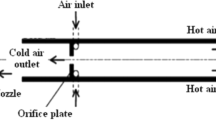Abstract
To improve the thermal performance of evaporative cooling process and reduce hydraulic resistance, a new vortex chamber has been designed with several stages of phase contact whose distinguishing feature is the arrangement of contact zones of swirling liquid and gas flows in the annular space of the chamber. The designed vortex chamber can operate stably in a wide range of loads, both high and low loads with respect to liquid and gas phases. Process design calculations of new contact elements are based on the criterion of energy efficiency. The best way for its estimation is by the Merkel and Kirpichev method. The hydraulic resistance and thermal power of the vortex chamber are determined under various operating conditions. The obtained dependence of hydraulic resistance on the spray rate in the vortex chamber makes it possible to estimate the energy efficiency of the chamber and select the best operating conditions according to the Kirpichev criterion. Expressions for calculation of heat and mass transfer coefficients are presented. The criterion equation enables us to determine whether the efficiency of the proposed device corresponds to the design value. The volumetric mass transfer coefficients encountered in the developed vortex chamber with known type of sprinklers are compared with experimental data. The developed vortex chamber has an enhanced mass transfer coefficient at the gas-to-liquid mass flowrate ratio of G/L > 0.5. The vortex chamber cooling capacity is maximized at low mass spray rates, i.e., at low hydraulic loads with respect to the liquid phase. To increase the energy efficiency of the used contact devices, the circulating water should be cooled at low average gas flow velocities.








Similar content being viewed by others
REFERENCES
H. Chen, X.-H. Ruan, Y.-H. Peng, Y.-L. Wang, and C.-K. Yu, “Application status and prospect of spray cooling in electronics and energy conversion industries,” Sustainable Energy Technol. Assess. 52, 102181 (2022). https://doi.org/10.1016/j.seta.2022.102181
N. Williamson, M. Behnia, and S. Armfield, “Comparison of a 2D axisymmetric CFD model of a natural draft wet cooling tower and a 1D model,” Int. J. Heat Mass Transfer 51, 2227–2236 (2008). https://doi.org/10.1016/j.ijheatmasstransfer.2007.11.008
. Ruiz, P. Navarro, M. Hernández, M. Lucas, and A. S. Kaiser, “Thermal performance and emissions analysis of a new cooling tower prototype,” Appl. Therm. Eng. 206, 118065 (2022). 10.1016/j.applthermaleng.2022.11806
R. Zhao, S. Bu, X. Zhao, L. Zhang, W. Xu, Z. Yu, J. Fang, Y. Ji, Y. Hu, and B. Bao, “Study on thermal performance of new finned heat exchange tube bundles in cooling tower,” Int. J. Therm. Sci. 168, 107064 (2021). https://doi.org/10.1016/j.ijthermalsci.2021.107064
G. Liang and I. Mudawar, “Review of spray cooling — Part 1: Single-phase and nucleate boiling regimes, and critical heat flux,” Int J. Heat Mass Transfer 115, 1174–1205 (2017). https://doi.org/10.1016/j.ijheatmasstransfer.2017.06.029
J. Breitenbach, I.-V. Roisman, and C. Tropea, “From drop impact physics to spray cooling models: A critical review,” Exp. Fluids 59, 55 (2018). https://doi.org/10.1007/s00348-018-2514-3
J. Lu, Z. Liu, X. Xu, and J. Liu, “Experimental study of the falling film evaporative cooling on horizontal tubes plates,” Int. J. Refrig. 138, 108–117 (2022) https://doi.org/10.1016/j.ijrefrig.2022.03.013
A. M. Abed, M. A. Alghoul, M. H. Yazdi, A. N. Al-Shamani, and K. Sopian, “The role of enhancement techniques on heat and mass transfer characteristics of shell and tube spray evaporator: A detailed review,” App-l. Therm. Eng. 75, 923–940 (2015). https://doi.org/10.1016/j.applthermaleng.2014.10.020
A. V. Dmitriev, I. N. Madyshev, V. V. Kharkov, O. S. Dmitrieva, and V. E. Zinurov, “Experimental investigation of fill pack impact on thermal-hydraulic performance of evaporative cooling tower,” Therm. Sci. Eng. Prog. 22, 100835 (2021). https://doi.org/10.1016/j.tsep.2020.100835
I. N. Madyshev, V. V. Khar’kov, and A. N. Nikolaev, Intensification of Heat and Mass Transfer Processes in Evaporative Cooling Towers (Kazan. Nats. Issled. Tekhnol. Univ., Kazan, 2022) [in Russian].
I. N. Madyshev, V. V. Khar’kov, and A. V. Dmitriev, “Contact device for heat-and-mass exchanger apparatus,” Pat. Appl. No. 2022103039, Russia (February 8, 2022).
K. Ma, M. Liu, and J. Zhang, “Online optimization method of cooling water system based on the heat transfer model for cooling tower,” Energy 231, 120896 (2021). https://doi.org/10.1016/j.energy.2021.120896
V. S. Ponomarenko and Yu. I. Aref’ev, Cooling Towers of Industrial and Energy Enterprises (Energoatomizdat, Moscow, 1998) [in Russian].
A. G. Laptev and I. A. Ved’gaeva, Design and Calculation of Industrial Cooling Towers (Kazan. Gos. Energ. Univ., Kazan, 2004) [in Russian].
A. G. Laptev, V. A. Danilov, and I. V. Vishnyakova, “Evaluating the effectiveness of circulating water cooling in a cooling tower,” Therm. Eng. 51, 661–665 (2004).
O. S. Dmitrieva, I. N. Madyshev, and A. V. Dmitriev, “Determination of the heat and mass transfer efficiency at the contact stage of a jet-film facility,” J. Eng. Phys. Thermophys. 90, 651–656 (2017). https://doi.org/10.1007/s10891-017-1612-z
D. Bergman, “Evaporative cooling towers: State-of-the-art designs and advantages of reconstruction,” Energetik, Special Issue, 15–21 (2000).
J. Kloppers and D. Kröger, “A critical investigation into the heat and mass transfer analysis of counterflow wet-cooling towers,” Int. J. Heat Mass Transfer 48, 765–777 (2005). https://doi.org/10.1016/j.ijheatmasstransfer.2004.09.004
Funding
The study was financially supported by the Russian Sсience Foundation (grant no. 21-79-00001 (https://rscf. ru/project/21-79-00001/)).
Author information
Authors and Affiliations
Corresponding author
Additional information
Translated by T. Krasnoshchekova
Rights and permissions
About this article
Cite this article
Madyshev, I.N., Dmitrieva, O.S., Kharkov, V.V. et al. Determining Hydraulic Resistance and Volumetric Heat and Mass Transfer Coefficients during Cooling of Circulating Water in a Multistage Vortex Chamber. Therm. Eng. 69, 963–970 (2022). https://doi.org/10.1134/S0040601522110039
Received:
Revised:
Accepted:
Published:
Issue Date:
DOI: https://doi.org/10.1134/S0040601522110039




